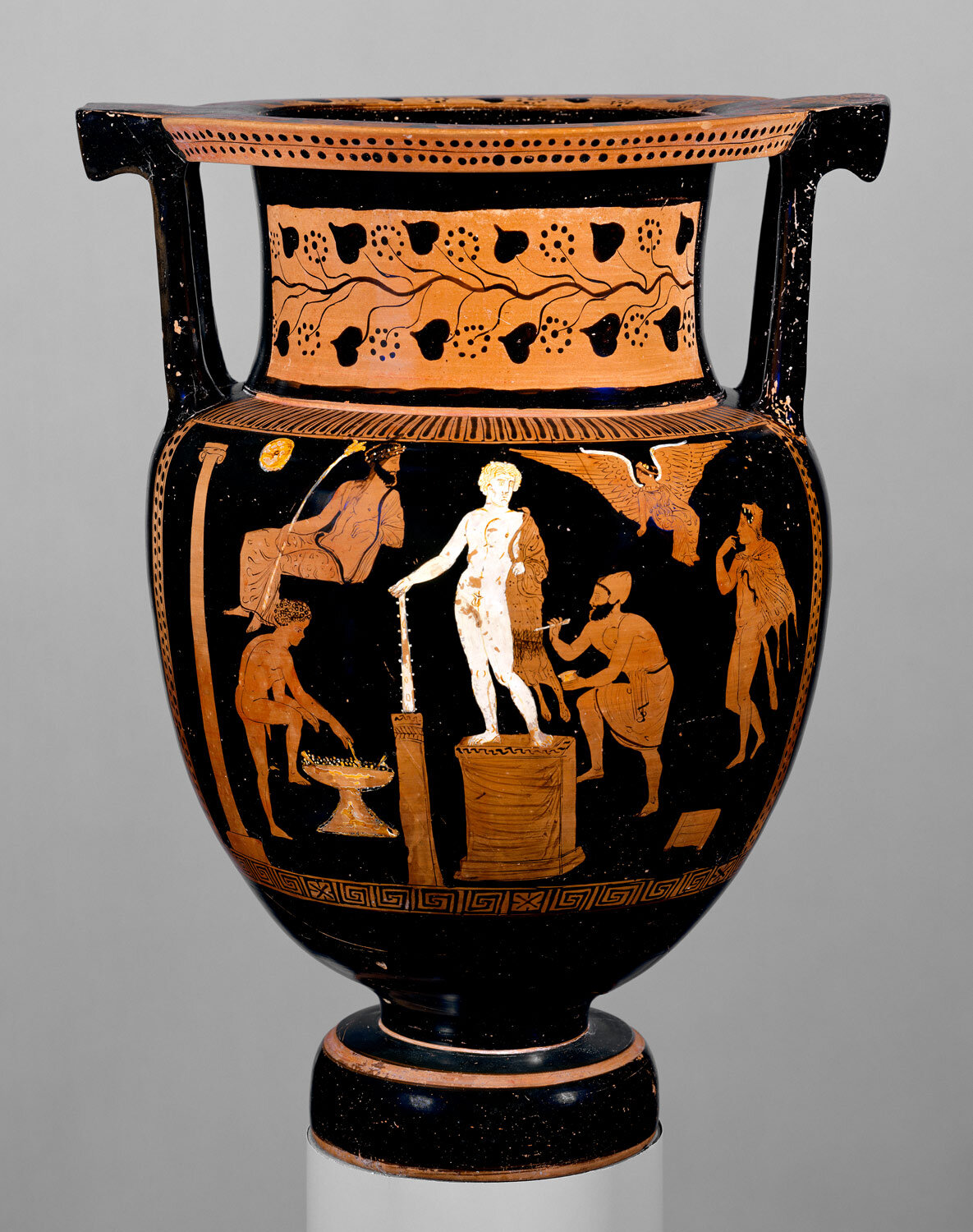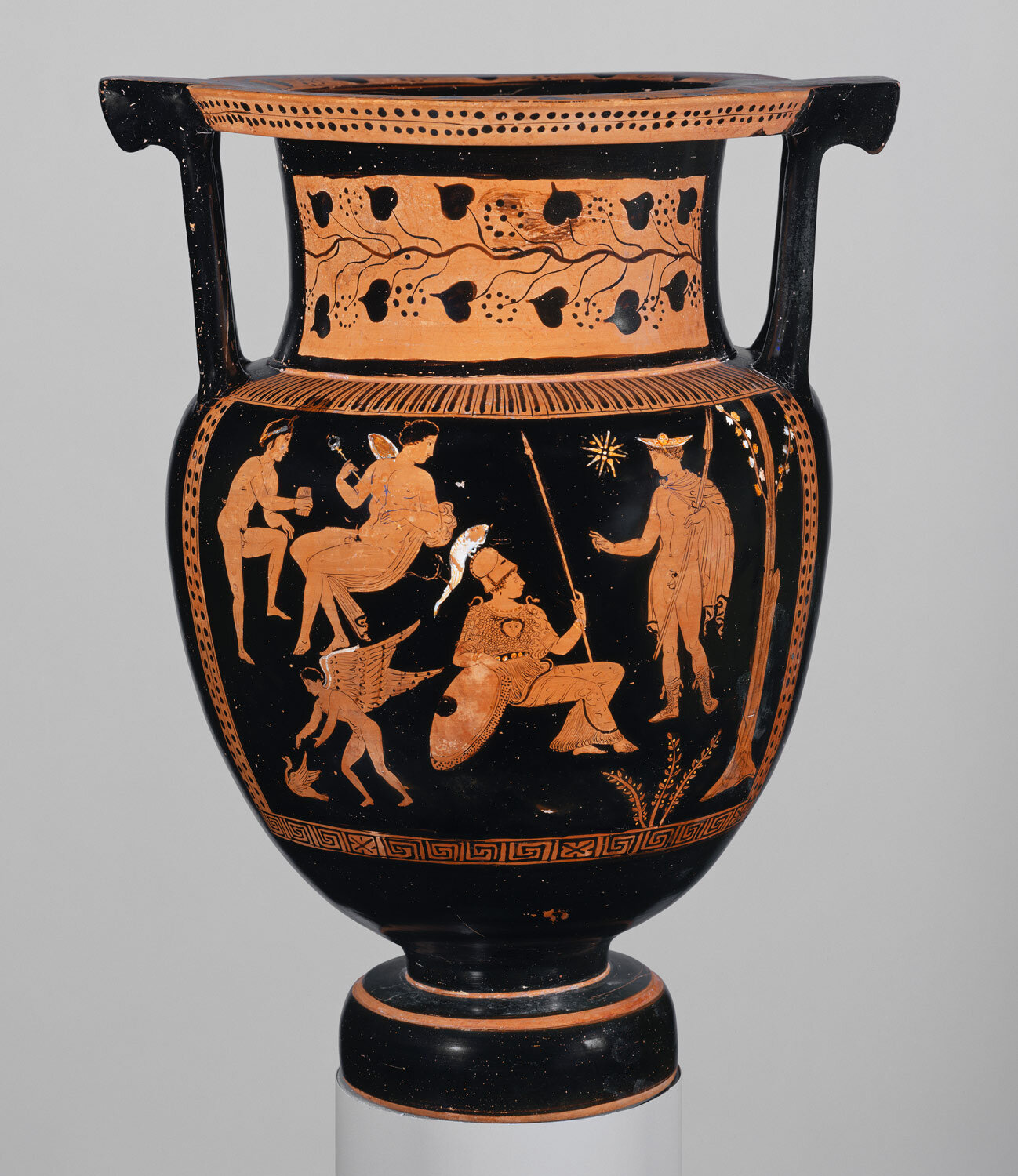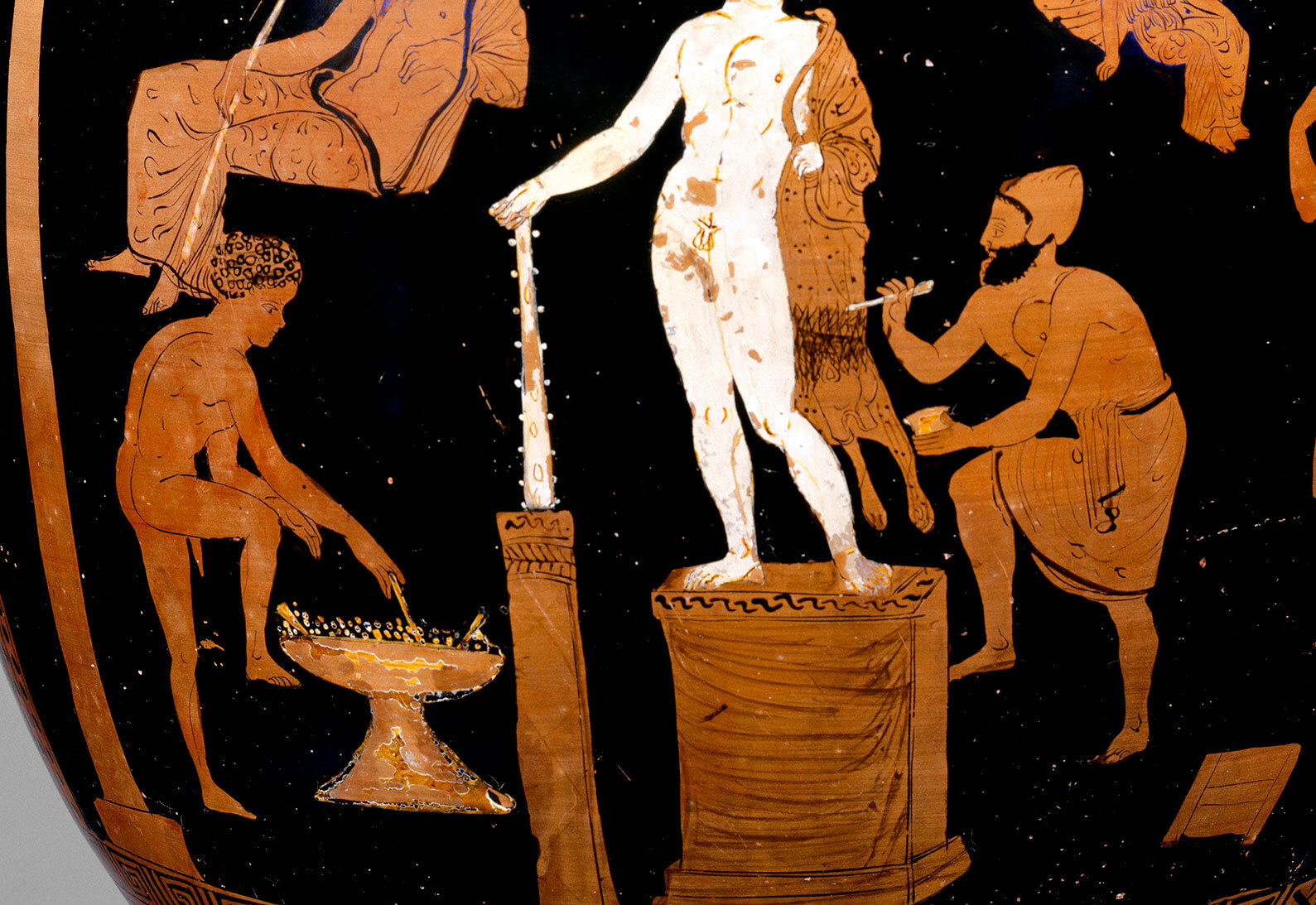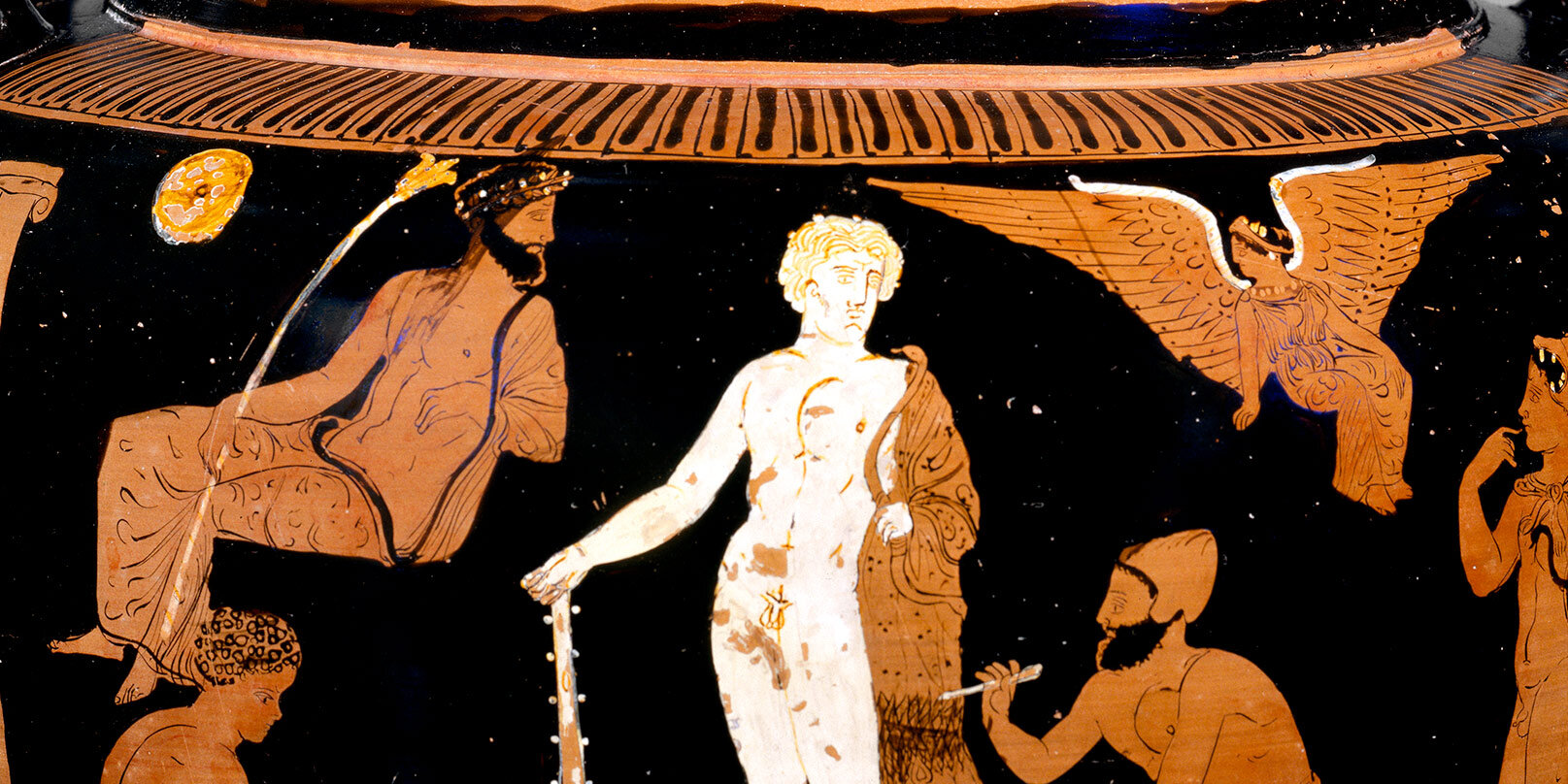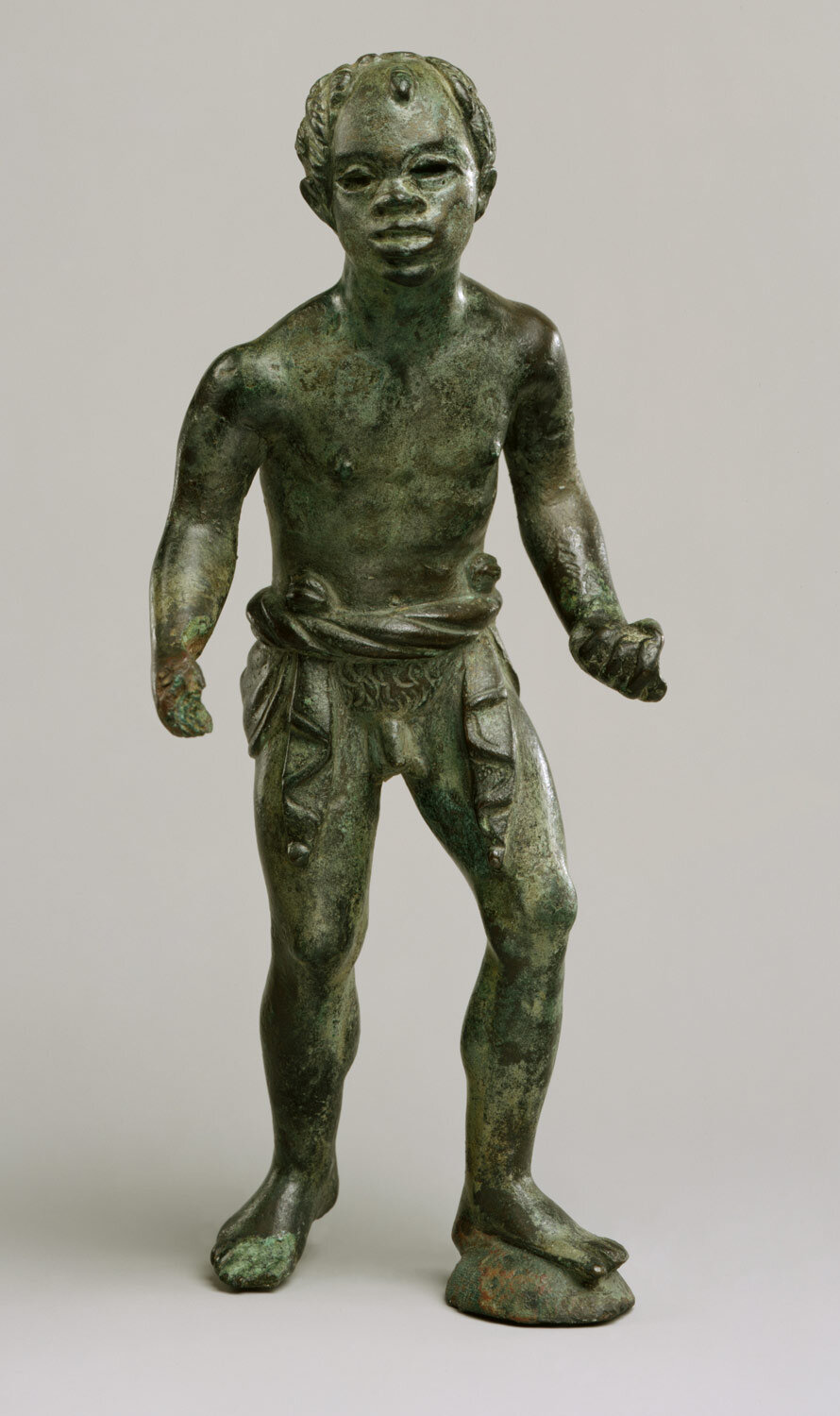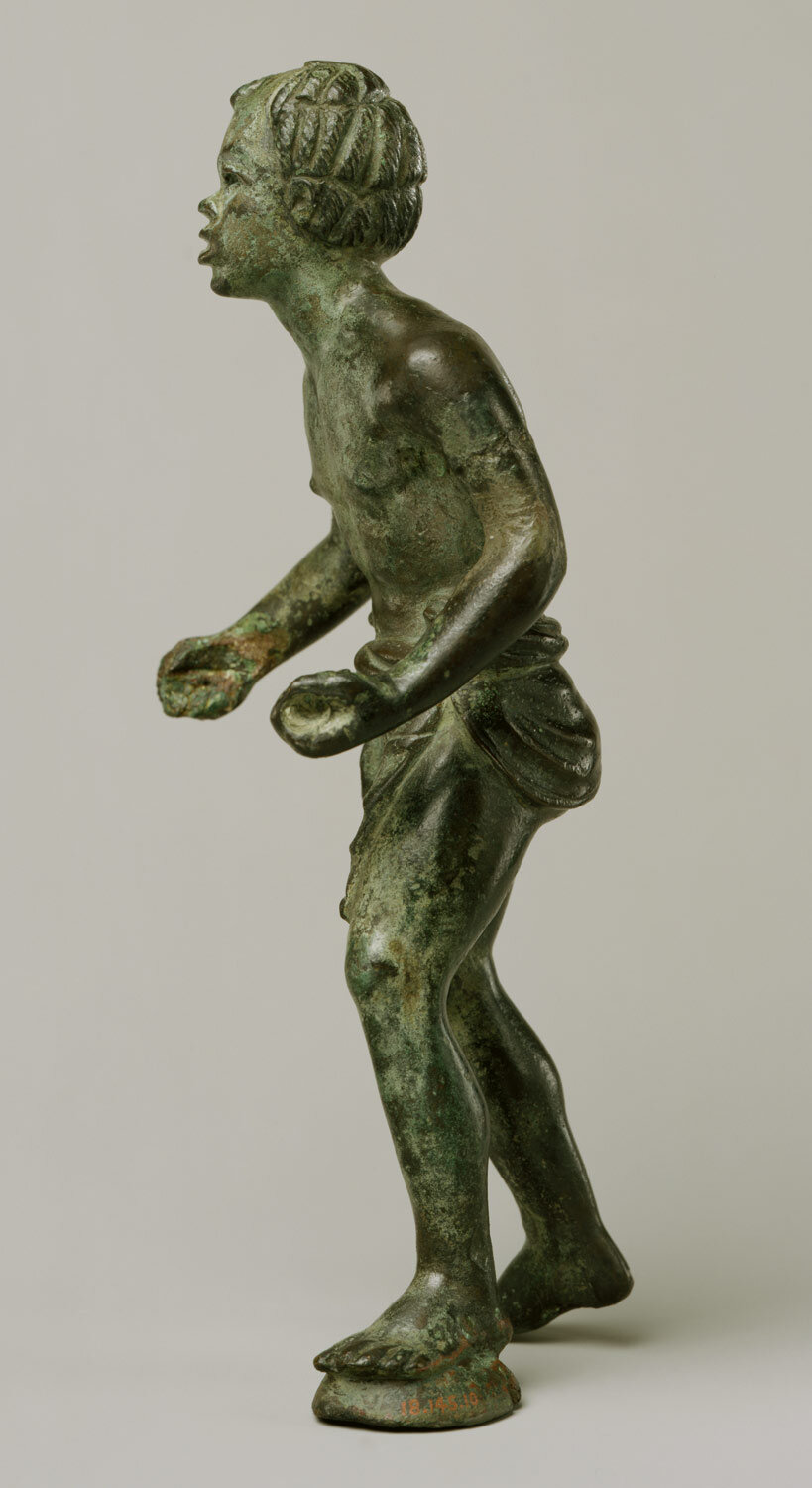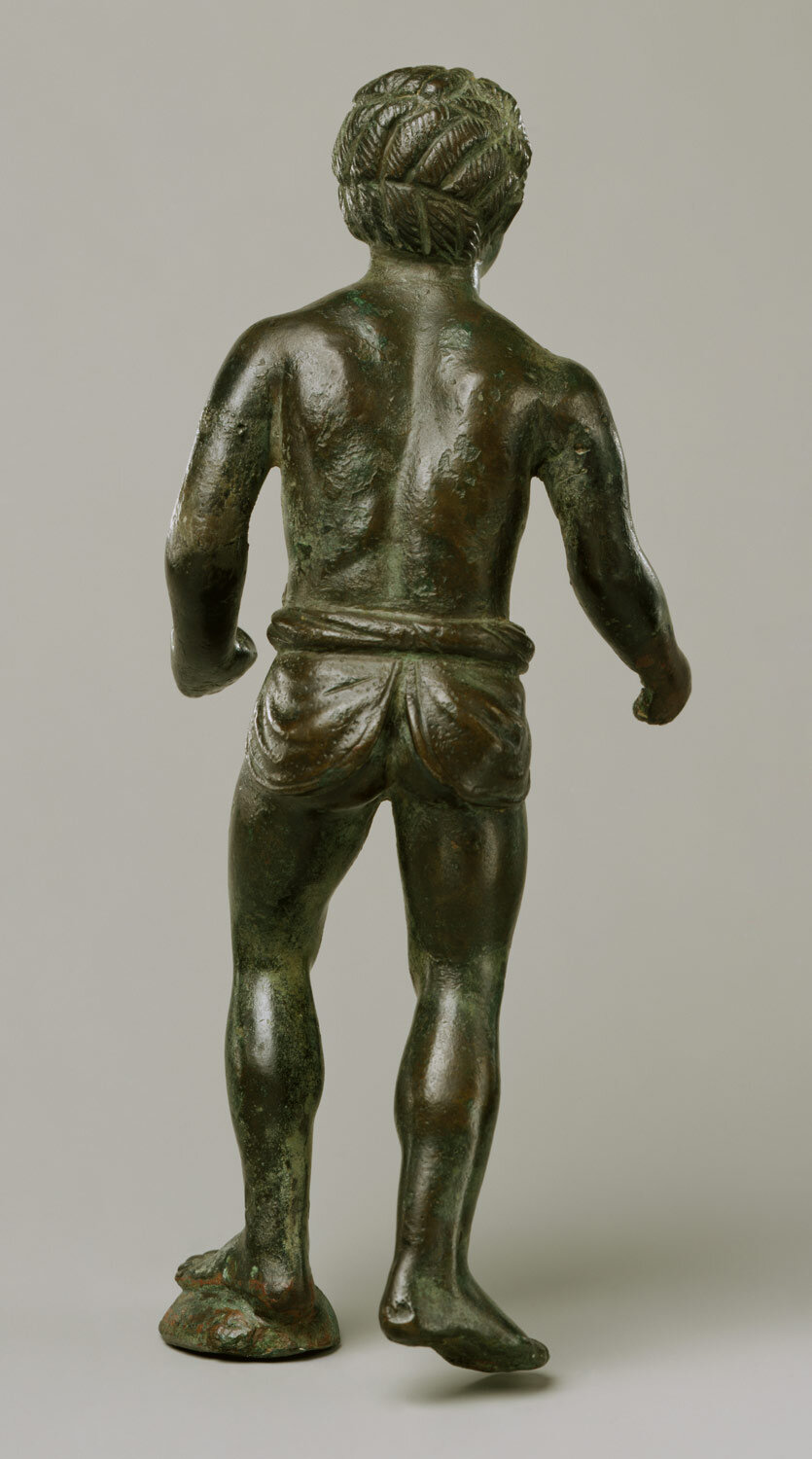Tales of Ethiopia as a mythical land at the farthest edges of the earth are recorded in some of the earliest Greek literature of the eighth century B.C., including the epic poems of Homer. Greek gods and heroes, like Menelaos, were believed to have visited this place on the fringes of the known world. However, long before Homer, the seafaring civilization of Bronze Age Crete, known today as Minoan, established trade connections with Egypt. The Minoans may have first come into contact with Africans at Thebes, during the periodic bearing of tribute to the pharaoh. In fact, paintings in the tomb of Rekhmire, dated to the fourteenth century B.C., depict African and Aegean peoples, most likely Nubians and Minoans. However, with the collapse of the Minoan and Mycenaean palaces at the end of the Late Bronze Age, trade connections with Egypt and the Near East were severed as Greece entered a period of impoverishment and limited contact.
Attic kantharos shaped with a double head: Heracles and an African man.
Attica
About 480-470 BC
During the eighth and seventh centuries B.C., the Greeks renewed contacts with the northern periphery of Africa. They established settlements and trading posts along the Nile River and at Cyrene on the northern coast of Africa. Already at Naukratis, the earliest and most important of the trading posts in Africa, Greeks were certainly in contact with Africans. It is likely that images of Africans, if not Africans themselves, began to reappear in the Aegean. In the seventh and early sixth centuries B.C., Greek mercenaries from Ionia and Caria served under the Egyptian pharaohs Psamtik I and II.
African Head on a Greek Coin, ca. 450 BC
African Head on a Greek Coin ca. 560-545 BC
All black Africans were known as Ethiopians to the ancient Greeks, as the fifth-century B.C. historian Herodotus tells us, and their iconography was narrowly defined by Greek artists in the Archaic (ca. 700–480 B.C.) and Classical (ca. 480–323 B.C.) periods, black skin color being the primary identifying physical characteristic. It is recorded that Ethiopians were among King Xerxes’ troops when Persia invaded Greece in 480 B.C. Thus, the Greeks would have come into contact with large numbers of Africans at this time. Nonetheless, most ancient Greeks had only a vague understanding of African geography. They believed that the land of the Ethiopians was located south of Egypt. In Greek mythology, the pygmies were the African race that lived furthest south on the fringes of the known world, where they engaged in mythic battles with cranes
Terracotta aryballos (oil flask) - Period: Archaic - Date: ca. 570 B.C.
Around the lip, pygmies fighting cranes
Around the main surface of the handle, three satyrs; on the ends, Hermes and Perseus; on top, two tritons
Both potter and painter, Nearchos was one of the great artists active about 570 B.C. His son, Tleson, was the major potter of Little Master cups in the succeeding generation. Both were literate; they inscribed their vases. This aryballos is exceptional for the precision and vigor of the figures.




Ethiopians were considered exotic to the ancient Greeks and their features contrasted markedly with the Greeks’ own well-established perception of themselves. The black glaze central to Athenian vase painting was ideally suited for representing black skin, a consistent feature used to describe Ethiopians in ancient Greek literature as well.
Ethiopian's head and female head, with a kalos inscription. Attic janiform red-figure aryballos, ca. 520–510 BC. From Greece.
A kalos inscription (καλός) is a form of epigraph found on Attic vases and graffiti in antiquity, mainly during the Classical period from 550 to 450 BC. The word kalos (καλός) means "beautiful"
Janiform kantharos with addorsed heads of a male or female African and a female Greek
ca. 480-470 B.C.
This two-handled wine cup is an example of an Athenian genre that joins an African male head with that of a Greek female. The transposed skin and hair colors connect the figures visually while emphasizing their differences. African artists employed specific hairstyles to convey a figure’s class, religious affiliation, or social standing, but this Greek artist relied on racial stereotypes. The African man is sculpted with curly hair, thick lips, and a flat nose and painted with a black clay gloss. The two subjects may represent a visual exposition of Herodotus’s theories of racial difference or a display of slaves and female companions in the service of Greek men.
Ethiopians were featured in the tragic plays of Aeschylus, Sophokles, and Euripides; and preserved comic masks, as well as a number of vase paintings from this period, indicate that Ethiopians were also often cast in Greek comedies.
Well into the fourth century B.C., Ethiopians were regularly featured in Greek vase painting, especially on the highly decorative red-figure vases produced by the Greek colonies in southern Italy (50.11.4). One type shows an Ethiopian being attacked by a crocodile, most likely an allusion to Egypt and the Nile River. Depictions of Ethiopians in scenes of everyday life are rare at this time, although one tomb painting from a Greek cemetery near Paestum in southern Italy shows an Ethiopian and a Greek in a boxing competition.
Rhyton, black male attacked by crocodile. Red-figured, height 0.222 m, width 0.14 m, depth 0.10 m. Classical Period, circa 350 B.C.
With the establishment of the Ptolemaic dynasty and Macedonian rule in Egypt, after the death of Alexander the Great in 323 B.C., came an increased knowledge of Nubia (in modern Sudan), the neighboring kingdom along the lower Nile ruled by kings who resided in the capital cities of Napata and later Meroë. Cosmopolitan metropolises, including Alexandria in the Nile Delta, became centers where significant Greek and African populations lived together.
Terracotta column-krater (bowl for mixing wine and water)ca. 360–350 B.C.
To the left, an African boy tends the brazier on which rods are heating that will spread the tinted wax.
During the Hellenistic period (ca. 323–31 B.C.), the repertoire of African imagery in Greek art expanded greatly. While scenes related to Ethiopians in mythology became less common, many more types occurred that suggest they constituted a larger minority element in the population of the Hellenistic world than the preceding period. Depictions of Ethiopians as athletes and entertainers are suggestive of some of the occupations they held. Africans also served as slaves in ancient Greece, together with both Greeks and other non-Greek peoples who were enslaved during wartime and through piracy.
Bronze statuette of an African (known as Ethiopian) youth
Period: Hellenistic
Date: 3rd–2nd century B.C.
Culture: Greek
Medium: Bronze
Dimensions: H. 18.29 cm.
Classification: Bronzes
Terracotta vase in the form of a sleeping African (known as Ethiopian) boy
Terracotta vase in the form of a sleeping African (known as Ethiopian) boy
Period: Hellenistic
Date: ca. 3rd–2nd century B.C.
Culture: Cypriot - Greek
Medium: Terracotta
Dimensions: H. 8 3/16 in. (20.8 cm)
Large-scale portraits of Ethiopians made by Greek artists appear for the first time in the Hellenistic period, and high-quality works, such as images on gold jewelry and fine bronze statuettes, are tangible evidence of the integration of Africans into various levels of Greek society.
Source: artmuseum.princeton.edu - wikipedia.org - metmuseum.org
Citation: Hemingway, Sean, and Colette Hemingway. “Africans in Ancient Greek Art.” In Heilbrunn Timeline of Art History. New York: The Metropolitan Museum of Art, 2000–. http://www.metmuseum.org/toah/hd/afrg/hd_afrg.htm (January 2008)
















